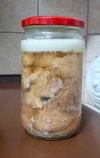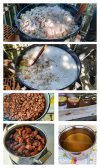Yep. When they are well sealed fats have a very long shelf life. The trick is to make sure you've filtered the fat well enough to get all the protein out of it as best you can. I've even seen some youtubers mention that if their jars are hot enough, the sealers warm enough (and dry, super important), that the jars should seal just from the lard/tallow cooling off.Lard has a long shelf life so when sealed should last a very long time.
That makes me a little nervous, so I still processed them in a water bath for 20-30 min. or so
This gal does just use heat for the seal, but she hits all the points on rendering, making sure all the moisture is driven off (and what that looks like), keeping the jars hot, etc. It's a really good outline of the process.




 . Does anyone else have any thoughts on this?
. Does anyone else have any thoughts on this?